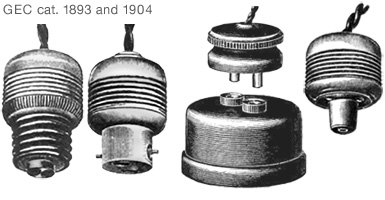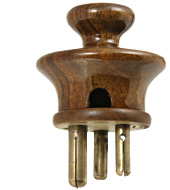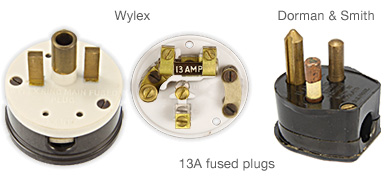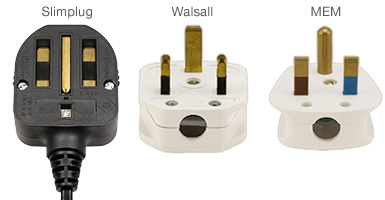 |
British plugs and sockets short history |
general info |
BS546 pages |
BS1363 pages |
 |
British plugs and sockets short history |
general info |
BS546 pages |
BS1363 pages |
| Britain has a rich history of plugs
and sockets. From the 1890s until 1940s a variety of round pin plugs
dominated the market for domestic use. The current type, with
rectangular pins, was introduced shortly after WW II, but round
pins have never disappeared fully in the UK and are still the dominant
type in India, South Africa and some other countries that once were
electrified by British companies. Text and images below give a concise overview of the history of domestic plugs. 'details' links refer to pages that give additional information and show images of matching sockets. Sources of information are given at the bottom of page. |
| Early models Although not the very first domestic plugs, the General Electric Company (GEC) offered already early 1890s plugs that fitted in Swan screw lamp fittings (comparable to Edison model) or bayonet lamp fittings (see also "Additional outlets" below). Plugs with two relative short pins, and concentric plugs were available too; see images right. Rating was not yet given in amps, but the number of lights that could be connected. The GEC 1911 catalog lists 2-pin plugs for domestic use rated at 3A ("Midget"), 5A ("Standard"} and 10A ("Union"). It had been found that "Union" could also handle 15A safely. Rating of a 1910s non-British Standard gauge* wooden 2-pin plug is unknown. The plug is not in the museum collection; images are made by John Cooper. * pin spacing = 19 mm, pin diameter = 7 mm. Earthed, 3-pin sockets were first made by A.P. Lundberg & Sons of London. Their "Tripin" model, designed in 1911 served as example for BS 317:1928 plugs (see next paragraph). Tripin and BS 317 5A pin configuration are nearly identical. The mid 1910s wooden 3-pin plug right has different pin specifications; see details. |
   |
| Standardization
BS 73:1915 was the first British Standard for 5A two-pin (not earthed) plugs and sockets. 15A and 30A were added to the 1919 version; 2A followed in 1927. BS 317:1928 was the first standard for 2A, 5A, 15A and 30A 3-pin (earthed) plugs and sockets. Spacing of line and neutral pins differs between two- and three-pin plugs. BS 372:1930 consisted of two parts. Part 1 about 2-pin and Part 2 about 3-pin plugs and sockets. Pin specification remain identical compared to respectively BS 73 and BS 317. Cord side-entry was compulsory for both 2- and 3-pin plugs. BS 372 Part 1 was withdrawn in 1970 with the introduction of BS 4573 2-pin shaver plugs and sockets. Domestic use of other not earthed plugs was no longer allowed in the UK; see details. BS 546:1934, superseding BS 372 Part 2, specified earthed round pin plugs and matching sockets; see details. Although from 1950s no longer the domestic standard, BS 546 is still used for special applications, among others in theaters. Shown plugs have (partially) split round pins, necessary for good contact with socket contact tubes. After significant improvements of socket contacts, by MK Electric in 1933 (see Safety Aspects, below), plugs with solid pins became standard. |
  |
| Additional outlets Initially electricity in homes was used for lighting only, but development of electrical appliances started soon thereafter. Up until the early 1930s home wiring was often restricted to a ceiling light socket and in some rooms a single wall socket. Already in the early days there was a demand for additional outlets. The image right shows three options. Wall socket adapter: 1904 GEC catalog. CAG switch with outlet: image John Cooper. Inset: wooden plug (see above) that is compatible with the outlet. Bayonet cap plug: see details. |
  |
| BS 1363 Plugs and sockets, introduced in 1947, were the result of many years of study and debate into the needs of post-war housing. A single plug, rated at 13A, was intended to replace the 2A, 5A land 15A BS 546 plugs and other 7A - 10A non-standard plugs. Safety aspects were an important issue in development of the new plug and socket. Already existing child-safe sockets shutters became obligatory (see next paragraph and BS 1363 page). In connection to the design of the new "all-purpose" plug it was decided to introduce ring wiring in homes, rather than radial wiring. A related safety measure was that all BS 1363 plugs must have a fuse (13A or less). See Radial-Ring circuit pages for details. |
 |
| Safety aspects MK Electric introduced safety sockets in 1928. The design to open the L and N contact shutter by inserting the longer earth pin was patented in 1936 (see details). Sockets contacts based on tubes had little flexibility. A new design, patented in 1933 by MK provided a reliable pin contact. Adapters for not earthed (Euro)plugs have an Insulated Shutter Opening Device (ISOD), necessary to open BS 1363 shutters. BS 1363 plugs without earth pin or ISOD don't exist. From 1984 L and N pins must be partially sleeved. A requirement that applies also to BS 546 plugs and BS 4573 shaver plugs. |
 |
| Alternative 13A plugs The BS 1363 plug designed by MK Electric became the standard domestic plug in the UK, but two competitive models have existed. Wylex Works designed in 1926 a plug with hollow round earth pin and flat line and neutral pins. Image right shows a 13A fused plug version that complied with BS 1363; see details. Dorman & Smith patented in 1943 a 13A plug. A fuse screwed into the plug body served as line pin; see image far right (details). Neither Wylex nor D&S were selected as prevailed BS 1363 design, but both types have been used for about three decades. |
 |
| Non-standard plugs Over the years non-standard plugs have been developed for special - not domestic - purposes. Three examples, based on BS 1363, are are shown right. Find more on "Uncommon" page. Slimplug® is a folding plug for travelers who don't like carrying a rather bulky BS 1363 plug; see details. Walsall plugs with 90 degrees rotated rectangular pins are, among others, used by London Underground. Matching sockets cannot be used by travelers to recharge cell phones etc. Midland Electric Manufacturing plugs with round earth pin can be used with matching "clean earth" sockets; see details. |
 |
| Sources By personal communication: Ronald Camp / John Cooper / Lucien Nunes / David Peacock AC power plugs and sockets: British and related types, Wikipedia article https://en.wikipedia.org/wiki/AC_power_plugs_and_sockets:_British_and_related_types The remarkable evolution of BS 1363, by David Peacock. In: Wiring Matters, winter 2013, plublished by IET Electrical https://electrical.theiet.org/media/1485/bs_1363_socket_and_plug.pdf The origin of the BS 1353 plug and socket outlet system, by Malcolm Mullins. In: Wiring Matters, spring 2006, published by IET Electrical https://electrical.theiet.org/media/1688/the-origin-of-the-bs-1363-plug-and-socket-outlet-system.pdf The evolution of the socket (MK). In: The professional electrician & installer, 12 February 2019. https://professional-electrician.com/features/the-evolution-of-the-socket/ Plugging in: Power sockets, standards and valencies of national habitus, by Damon Taylor. In Journal of Material Culture, Nov. 24, 2014 https://journals.sagepub.com/doi/10.1177/1359183514557765l |
| |
D i g i t a l M u s e u m o f | |
P l u g s a n d S o c k e t s | |